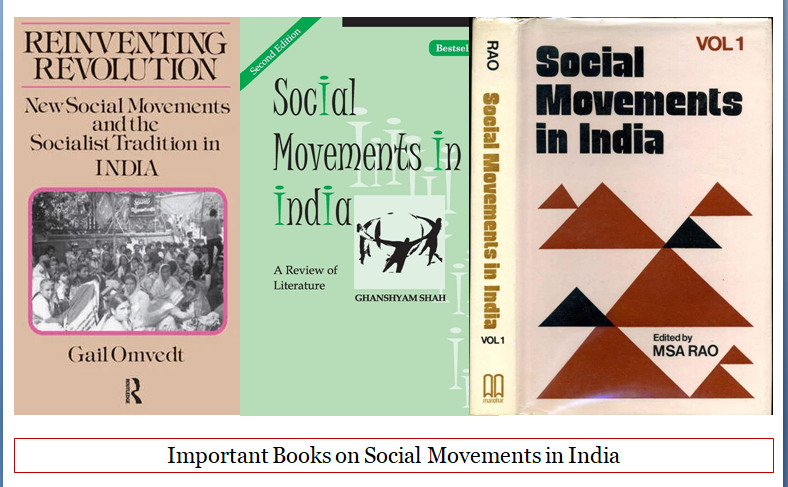 |
| Books Social Movements in India |
Lecture and Explanation
Understanding Social Movements in India
Key Words: Social Movements in India, Sociology for BA LLB
The Chaudhary Charan Singh University, Meerut, Uttar Pradesh, B.A. LL.B, Sociology - II (Legal System and Society), Paper Code: L 2002
Dear students, this is a slightly modified version of the PowerPoint Presentation which is used during the lecture. This modified version of the PPT is not a substitute for the lecture. The lecture was delivered comprehensively. This page will be updated to the full lecture later on.
Lecture: Understanding Social Movements in India
Definition of Social Movement
Turner and Killian:
“A collective acting with some continuity to promote or resist change in the society or group of which it is a part.”
Horton and Hunt:
“A social movement is a collective effort to promote or resist change”
Characteristics of Social Movement: MSA Rao
Madhugiri Shamarao Anathapadmanabha Rao (1926–1985) was a professor of sociology who had been a founder-member in 1959 of the Department of Sociology at the University of Delhi, India.
He was one of the prominent Indian sociologists, who had made an analysis of the nature of social movement in his book “Social Movements in India: Studies in Peasant, Tribal and Women's Movement” (1979).
According to MSA Rao, the major characteristics of the Social Movements are:
Collective Action
Oriented Towards Social Change
The essential elements of Social Moments are:
Ideological Base of Social Movements
Organizational Framework
The Techniques and Results
The Technique or method for social movements may be peaceful or conflict, violent or non-violent, compulsive or persuasive, democratic or undemocratic means or methods to achieve their goal.
Types of Social Movements
Based on their objective MSA Rao has classified into three main types of social movements.
1. Reform Movements
2. Revolutionary Movements
3. Reactionary or Revivalist Movements
In addition to the above-mentioned types of Social Movements Horton and Hunt, in their book Sociology (1984) added two other types of Social Movements.
4. Resistance Movement
5. Utopian Movements
FULL NAME: Paul B. Horton, (B. 1916), Chester L. Hunt, (1912-1994)
Types of Social Movements
1. Reform Movements
Reform movements are satisfied with the existing social order but believe that certain reforms are necessary in some special areas. The reformer endeavoured to change elements of the system as it currently stands.
For example: The Civil Rights Movements, Women’s Liberation Moments, Satyashodhak Samaj Movements, Safai Karamchari Movement, Peasant Movements, Labour Movements, Workers Movements, etc
2. Revolutionary Movements
The Revolutionary movements deny that the system will ever work. These movements are deeply dissatisfied with the social order and work for radical change. They advocate replacing the entire existing structure. Their objective is the reorganization of society under their ideological blueprint. Revolutionary movements generally prefer not to use violence although some of them do resort to violence.
For example The Peasant Reform Movement, The Socialist Movement, The Communist Revolution of Russia and also China, The Indian National Freedom Movement, etc
3. Reactionary or Revivalist Movements
Some movements are known as reactionary or regressive movements. These aim at “putting the clock back”. Their members view certain social changes with suspicion and distaste and try to reverse the current trends. They strongly criticise the fast-moving changes of the present.
For Example The Catholic Counter-Reformation, The Brahmo Samaj, The Arya Samaj, The Sarvoday Movement, The Khadi and Gramodyog Movement, etc.
4. Resistance Movement
These movements are formed to resist a change that is already taking place in society. The many social and cultural changes of recent decades have been profoundly disturbing to many Indians who feel that our national virtue, traditional values, and cultural greatness are being eroded by secularism, minority appeasement, moral degradation, political corruption, the sell-out of national interest for the partial poetical interest, and so on. A good number of contemporary resistance movements express their dismay at the direction in which our nation has been moving.
For Example: the Anti Abortion Movement, the Anti Hindi Movement, the Anti Reservation Movement, The Swadeshi Movement, the Movement Against Globalization, Liberalization, and Industrialization, etc.
5. Utopian Movement
There are attempts to take society or at least a section of it towards a state of perfection.
To Ian Robertson, “These are loosely structured collectivities that envision a radically changed and blissful state, either on a large scale at some time in the future, or on a smaller scale in the present. The utopian ideals and the means of it are often vague, but many utopian movements have quite specific programmes for social change.”
For Example: the Hare Krishna Movement of the Seventies, the Movement for Establishing the Rama Rajya, Stateless Society, Classless Society, etc
ADDITIONAL INFORMATION:
Saint Thomas More (England, 1478-1535), was an English lawyer, judge, social philosopher, author, statesman, and noted Renaissance humanist. He wrote Utopia, in 1516, which describes the political system of an imaginary island state.
For Further Reading:
https://radicalnotes.org/2010/10/04/a-review-of-social-movements-i-ii/
Anil Kumar | Student of Life World









0 Comments